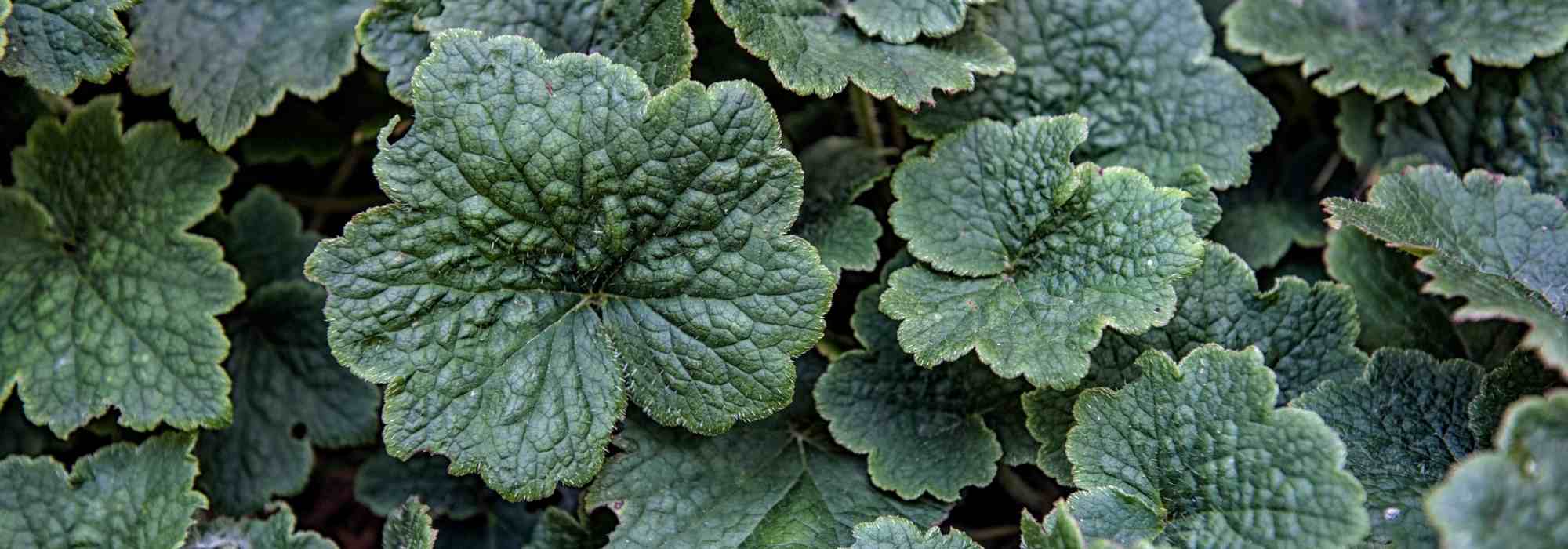
Tellima grandiflora: planting, care
Contents
Tellima grandiflora in a nutshell
- It is a very good groundcover for bright understoreys
- It has semi-evergreen foliage that turns reddish-purple in autumn
- It forms a clump rarely exceeding 50 cm in height
- It flowers with pearly pink bell-shaped blooms borne on slender stems
- Very hardy, it thrives in shade or partial shade in any well-drained soil
A word from our expert
Tellima grandiflora is a vigorous perennial groundcover similar to Heucheras and Tiarellas, with which it shares a close relationship. Like them, it has very decorative foliage, such as Tellima grandiflora ‘Rubra’, which persists even in winter, especially if the winter is mild. However, while it enjoys semi-shaded spots like its cousins, it tolerates dry soil much better. Not fearing root-filled soils, Tellima grandiflora makes an excellent evergreen groundcover for dry shade.
With its foliage changing with temperature fluctuations and the seasons, this groundcover perennial brightens up shaded, cool corners and light woodlands in the garden. It quickly forms elegant clumps topped from spring to summer with a long flowering of light spikes bearing white or pink flowers.
Very hardy, it is easy to grow in any well-drained soil, away from scorching sun.
For lovers of beautiful foliage, discover our tellimas, stunning even in winter!
Description and botany
Botanical data
- Latin name Tellima grandiflora
- Family Saxifragaceae
- Common name Fringe cups
- Flowering April to July
- Height 0.30 to 0.60 m
- Exposure Sun, partial shade
- Soil type Well-drained
- Hardiness -15 °C and beyond
The Tellima grandiflora is a perennial groundcover belonging to the Saxifragaceae family, just like the Heucheras to which it bears a resemblance. It combines the best characteristics of its two cousins: highly decorative and evergreen foliage, along with a long and abundant flowering of bell-shaped blooms from spring to summer. It is native to the cool understory, torrent edges, and humid forests of western North America, found from California to Alaska and on the rocky slopes of the Sierra.
While the genus Tellima currently includes 10 species, only the grandiflora species is cultivated in our gardens. It comes in several varieties, such as Tellima grandiflora ‘Rubra’, which features green and purple foliage that takes on lovely autumn hues.
The Tellima grandiflora forms a rosette clump that does not exceed 50 cm in height at maturity, with a width of 30 cm. The smaller varieties, like ‘Forest Frost’, measure less than 20 cm tall in foliage. The plant roots quickly thanks to its rhizomes, forming an attractive groundcover that is also useful for stabilising an unstable slope due to its root system.
The Tellima grandiflora is characterised by the density and elegance of its foliage, which varies in colour depending on the cultivars.
The evergreen to semi-evergreen leaves, depending on the severity of winter, are primarily basal, making Tellima an excellent groundcover. They are divided into 5 to 7 lobes with dentate margins, reminiscent of vine leaves. They measure 5 to 10 cm in diameter, are rounded, often heart-shaped or kidney-shaped. They are pubescent, with their lamina covered in rough hairs.
These elegantly cut leaves come in solid or variegated colours that change with temperature, becoming sumptuous in autumn. They display a beautiful veining that is often very pronounced and contrasting. Depending on the variety, they exhibit bright shades ranging from pale green to silver-green or acid green, sometimes marbled with yellow, shaded with red, or washed with bronze, or even purple. All take on beautiful autumn colours as the first frosts arrive, turning red in winter.
From May to July, fine pubescent flower spikes emerge from the foliage. The graceful and airy flowering blooms in spikes that can rise up to 80 cm above the foliage. The bell-shaped flowers, measuring 8 mm to 1 cm, are grouped in clusters of 15 to 35 flowers, cascading along the long stems. They consist of 5 fine, frayed petals that are greenish-white, cream-pink, red, or fringed with pink, and emit a light fragrance. Melliferous, they attract butterflies.
They then transform into capsules containing fine black seeds that readily self-sow. The plant propagates spontaneously by sowing.
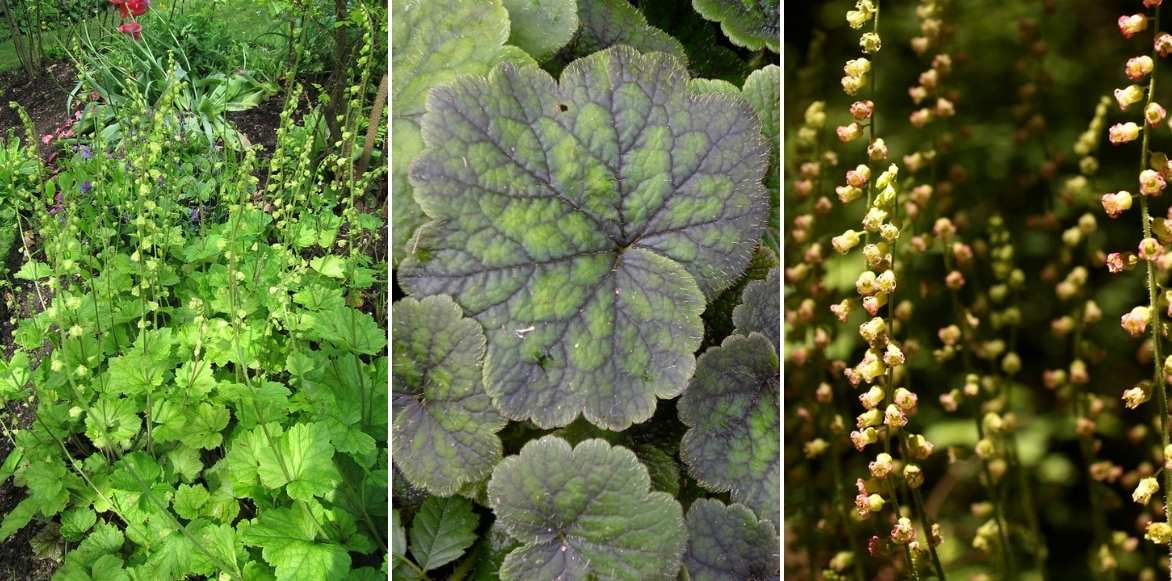
Main varieties
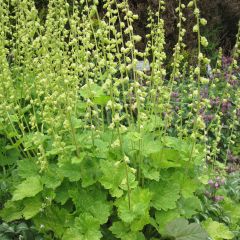
Tellima grandiflora
- Flowering time June to August
- Height at maturity 50 cm
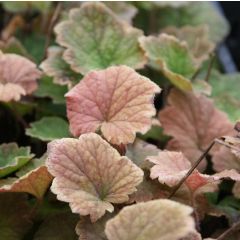
Tellima grandiflora Rubra
- Flowering time June to August
- Height at maturity 50 cm
Discover other Tellima
View all →Available in 1 sizes
Available in 1 sizes
Available in 1 sizes
Planting Tellima grandiflora
Where to plant it?
Tellima is a vigorous and accommodating perennial. It makes an excellent colourful groundcover that persists throughout winter in shaded and challenging areas of the garden without ever becoming invasive.
Easy to cultivate, it is very hardy, tolerating negative temperatures down to -20°C. It accepts all soils (acidic or neutral) that are moist or even occasionally dry in summer, provided they are well-drained in winter. However, it will develop more quickly in rich, humus-bearing soil. It thrives in shade or partial shade but is wary of very hot exposures that may scorch its foliage. It will tolerate a sunny, non-scorching position. It can endure dry shade under the cover of trees and bushes, where it does not fear competition from roots.
The Tellima is ideal for adding colour and brightness to borders, rockeries, light and cool understorey, or even beneath shrubs in beds. Capable of smothering adventive plants, it is also useful for replacing lawn in shaded, hard-to-access areas of the garden.
When to plant it?
Planting should be done in spring or autumn, avoiding periods of frost and drought.
How to plant it?
Space the plants about 30 to 40 cm apart and count 7 pots per m² to create a well-covering groundcover. You can plant it in masses to replace the lawn in lightly trafficked and shaded areas.
- Dig a hole 2 to 3 times wider than the root ball
- Loosen the soil well to a depth with a fork
- Add compost and plant in a mixture of potting soil and garden soil
- Firm the soil
- Mulch and water regularly until established
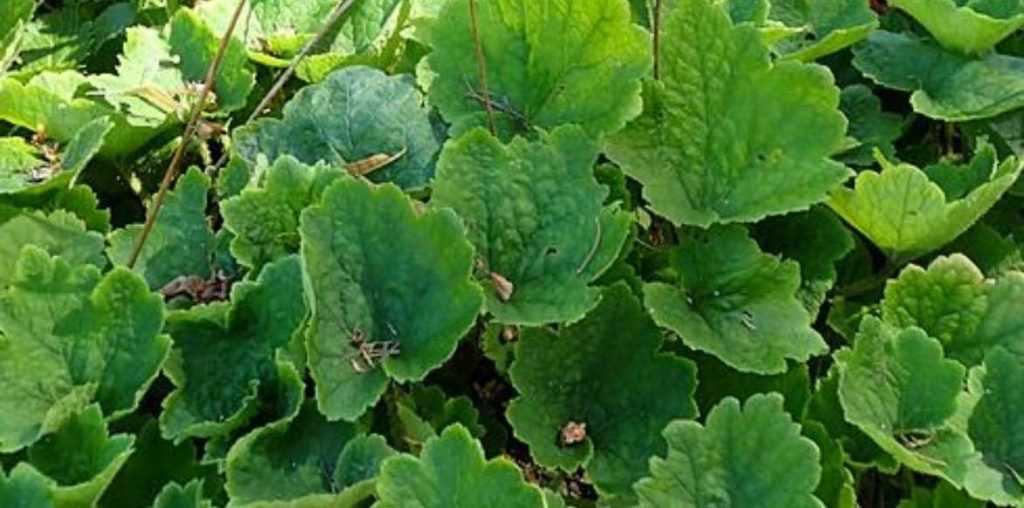
Tellima grandiflora (© Krzysztof-Ziarnek Kenraiz-Wikimedia commons)
Care
Beautiful in all seasons, especially during mild winters, Tellima grandiflora requires very little care.
You can amend the soil every spring by spreading a good layer of compost by scratching at the base.
Water regularly during the first year after planting, then 1 to 2 times a week during periods of intense heat or unusual drought. Afterwards, it will be tolerant of short dry spells.
Remove faded flower stems to limit spontaneous sowing and wilting leaves over time.
At the end of winter, before the growth resumes, give it a little spring cleaning by removing damaged leaves.
Diseases and potential pests
Discover our natural solutions to keep slugs and snails away from young foliage in spring.
Propagation
Tellima multiplies easily by division of clumps and by sowing as well, even though the plant self-seeds spontaneously.
Division
- In spring or autumn, use a fork to lift part of the clump by levering it up
- Separate leaf rosettes with roots
- Replant immediately in the ground and water
Sowing
As soon as the seeds are mature in autumn, sowing can be done.
- In a seed tray filled with good, moist seed compost, sow as sparsely as possible
- Lightly cover the seeds with compost
- Keep moist without excess until the seeds germinate
- Keep under a cold frame throughout the winter
- Transplant the seedlings in spring into individual pots
- Plant out in the garden the following autumn
Pairing ideas
The Tellima grandiflora is a fantastic groundcover that brightens up all shades, from cool to dry. With its highly decorative foliage all year round, it will enliven the atmosphere of leafy undergrowth, forming a beautiful colourful blanket under trees, beneath shrubs, even in soil riddled with roots. It thrives in the company of other perennial groundcovers such as columbines, Asarum, sedges, ferns, and Geranium phaeum ‘Album’. Under large trees, it makes a good companion for pulmonarias and, of course, for Heucherellas and Tiarellas, its classic partners.
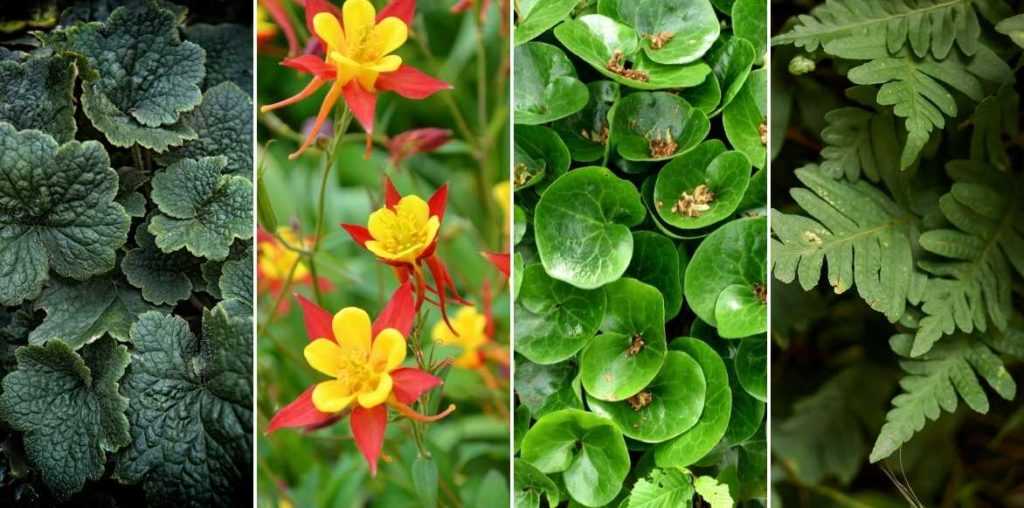
Tellima grandiflora alongside Columbines, Asarums, and Polypodium vulgare
In a bed with dappled sunlight, it will dress the base of hydrangeas, rhododendrons, camellias, and shade and semi-shade perennials such as hostas, periwinkles, bleeding hearts, epimediums, and comfreys.
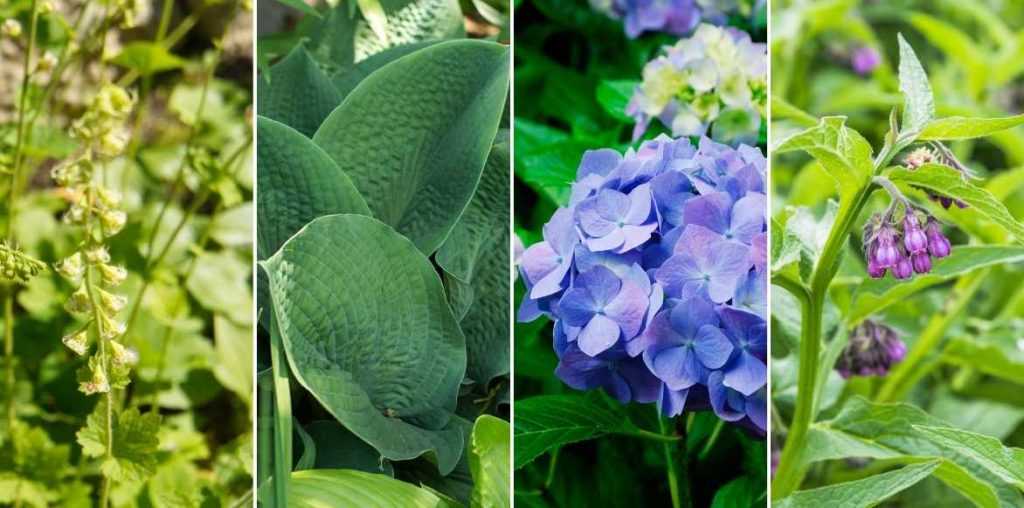
In a semi-shaded bed, Tellima pairs well with hostas, hydrangeas, and comfrey plants
Also consider its decorative potential in autumn, when its leaves turn red or purple; place it in the foreground of trees and shrubs with late-season colour such as maples, deciduous spindle trees, and smoke trees, or certain grasses like Pennisetum setaceum ‘Rubrum’ with its chocolate colour and the Miscanthus sinensis ‘Little Miss’ whose foliage turns crimson in the cold.
Useful resources
- Consider groundcover perennials and try our tried-and-true options
- Discover heucheras, these perennials closely related to Tiarellas and Heucherellas!
- Do you have a woodland area to flower? Get inspired by our advice sheets “What to plant under my trees?” and our solutions and suitable plants
- Subscribe!
- Contents































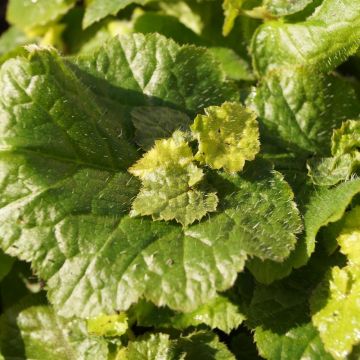


Comments